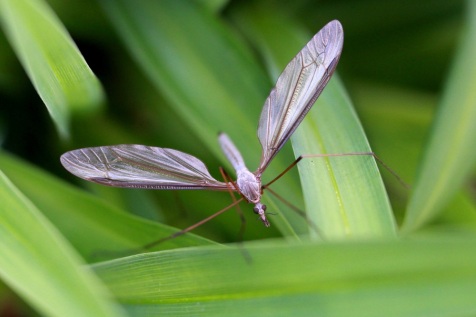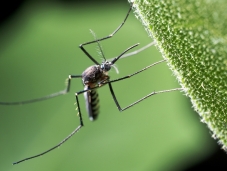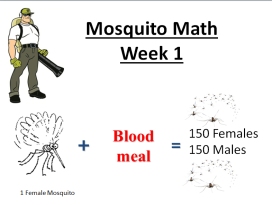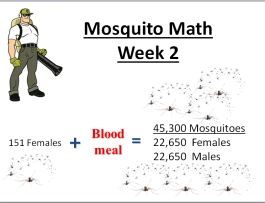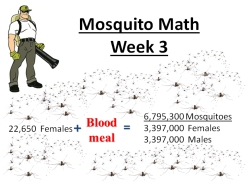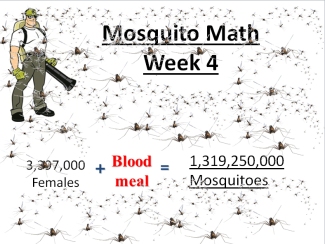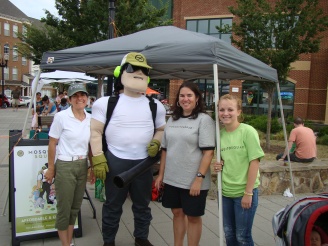L yme Disease is an acute inflammatory disease caused by the bite of a deer tick infected with the bacteria, Borrelia burgdorferi. The bacteria are the culprit of the infection, and as it enters the body can affect each person quite differently. The disease itself can present itself in a myriad of ways often being referred to as “the great pretender” by many because its symptoms often mimic those of other disorders. There are three stages of Lyme Disease, and each can wreak havoc on our bodies if the disease is not caught early or if the disease doesn’t respond well to treatment.
yme Disease is an acute inflammatory disease caused by the bite of a deer tick infected with the bacteria, Borrelia burgdorferi. The bacteria are the culprit of the infection, and as it enters the body can affect each person quite differently. The disease itself can present itself in a myriad of ways often being referred to as “the great pretender” by many because its symptoms often mimic those of other disorders. There are three stages of Lyme Disease, and each can wreak havoc on our bodies if the disease is not caught early or if the disease doesn’t respond well to treatment.
-
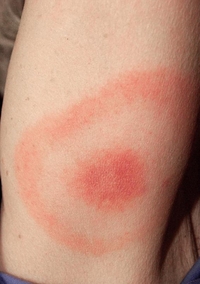
The well-known bulls-eye rash associated with Lyme Disease.
Stage #1 Early Lyme Disease —
Lyme Disease begins after an infected tick expels its salivary gland and abdominal contents into the skin of a human. In about 60-70% of cases, a rash may develop at the site of the tick bite. This rash is most often circular with a clear edge, but can be oblong or another shape. This rash is called Erythema Migrans of EM for short. The appearance of EM can begin from 3-30 days after a tick bite, or sometimes not at all. The rash is often mistaken as a spider or insect bite. The rash was aptly named “migrans” because it grows in size, gradually expanding over several days to greater than 2 inches across; sometimes covering a large, such as a patients’ entire back. As the center of the rash clears, it takes on a “bull’s-eye” appearance. The rash is usually not itchy or painful. Sometimes, other rashes occur in other parts of the body far away from the initial tick bite. This is because the spirochete gets transmitted quite rapidly in the bloodstream after the initial tick bite. Where the blood travels through the body the Borrelia spirochete also travel. In early Lyme disease, patients often experience moderate to severe flu-like symptoms (fatigue, chills, fever, headache, and muscle and joint aches, swollen lymph nodes). In approximately 18% of cases, the classic well-known CDC clinical features of Lyme disease are not present. In these cases, the only symptoms may be marked fatigue and flu-like symptoms. Given that fatigue and flu-like symptoms may often arise from other causes, (hence “the great pretender”) Lyme Disease may not even be considered a possibility in the diagnosis and the patient may suffer for many months with an unrecognized, untreated infectious illness.
-
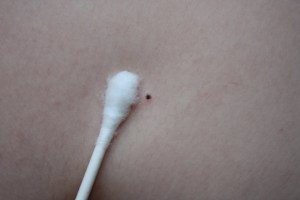
Tiny deer ticks can mean BIG trouble.
Stage #2 Late Disseminated Lyme Disease —
If Lyme Disease is not caught early and successfully treated it may then spread to many other parts of the body. This can occur over a period of days, affecting the central nervous system (brain), the peripheral nervous system (nerves), the cardiovascular system causing pericarditis and/or 2nd or 3rd degree heart block and possible death, the liver (causing mild hepatitis), the eyes (causing conjunctivitis). and the muscles and joints (causing migrating swelling, tenderness, and/or pain). Typically the symptoms associated with disseminated Lyme Disease include severe fatigue with a need for naps during the day, low-grade fevers, muscle and joint pains, sleep disturbance, irritability, headaches, light or sound sensitivity, sharp stabbing or shooting pains, and/or numbness and tingling..
 According to the Columbia University Medical Center Lyme and Tick-Borne Diseases Research Center, when Lyme Disease first affects the nervous system, one may experience symptoms of meningitis, encephalitis, or cranial neuritis:
According to the Columbia University Medical Center Lyme and Tick-Borne Diseases Research Center, when Lyme Disease first affects the nervous system, one may experience symptoms of meningitis, encephalitis, or cranial neuritis:
Meningitis is characterized by headaches that fluctuate in intensity from mild to severe with or without associated nausea, vomiting, light sensitivity, neck stiffness, or pain on eye motion.
Encephalitis is commonly accompanied sleepiness, mood swings and irritability, atypical spontaneous tearfulness or personality change, cognitive problems (typically with word finding problems, memory loss, slowed mental speed), balance problems, and sensory hyperarousal.
Cranial Neuritis.also referred to as CN VII Palsy (facial nerve weakness) is a form of cranial neuritis that is thought by many physicians to be common, however studies suggest that it may be seen in as few as 10% of patients with neurologic Lyme Disease. However, in a patient from a Lyme endemic area or in an individual who has previously visited a Lyme endemic area, a presentation of a facial nerve palsy should lead the physician to test for Lyme Disease. If the CN VII palsy affects both sides of the face, then Lyme Disease should be even more strongly considered as very few diseases cause a bilateral facial nerve palsy. Typically, a cranial neuritis occurs within days to weeks of the initial infection.
Radiculoneuritis. When the infection in Lyme disease affects the nerve roots, it is called radiculoneuropathy. Typical symptoms include radicular pain and symmetric or asymmetric sensory abnormalities, such as numbness or tingling. The radicular pain may be experienced as sharp stabbing or burning or shooting pains that radiate down a dermatomal distribution, such as into the limbs or across the trunk. There may also be elements of motor weakness.
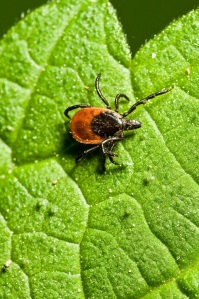 Stage #3 Late Neurologic Lyme Disease — Additionally Late stage Lyme Disease can also cause Encephalomyelitis and Neuropsychiatric Lyme Disease. Neuropsychiatric symptoms can emerge early or late in the disseminated phase of infection. These symptoms commonly appear as cognitive symptoms (as in the encephalopathy above) and as irritability, easy tearfulness, anxiety, and depression. Neurologic Lyme Disease can also affect hearing and vision in many patients. Patients may develop cognitive problems from Lyme Disease either early or many months or years after the initial infection. The cognitive problems most commonly include problems with short-term memory, problems with verbal fluency such as in name or word retrieval, and problems with slower speed of thinking. Patients typically report that they have “Brain Fog“, this is attributed to Encephalopathy. Inflammation from Lyme Disease can slow down the brain, aggravate symptoms of pain, swelling, poor concentration, and mood swings.
Stage #3 Late Neurologic Lyme Disease — Additionally Late stage Lyme Disease can also cause Encephalomyelitis and Neuropsychiatric Lyme Disease. Neuropsychiatric symptoms can emerge early or late in the disseminated phase of infection. These symptoms commonly appear as cognitive symptoms (as in the encephalopathy above) and as irritability, easy tearfulness, anxiety, and depression. Neurologic Lyme Disease can also affect hearing and vision in many patients. Patients may develop cognitive problems from Lyme Disease either early or many months or years after the initial infection. The cognitive problems most commonly include problems with short-term memory, problems with verbal fluency such as in name or word retrieval, and problems with slower speed of thinking. Patients typically report that they have “Brain Fog“, this is attributed to Encephalopathy. Inflammation from Lyme Disease can slow down the brain, aggravate symptoms of pain, swelling, poor concentration, and mood swings.
Additionally Late stage Lyme Disease can also cause Encephalomyelitis and Neuropsychiatric Lyme Disease. Neuropsychiatric symptoms can emerge early or late in the disseminated phase of infection. These symptoms commonly appear as cognitive symptoms (as in the encephalopathy above) and as irritability, easy tearfulness, anxiety, and depression. Neurologic Lyme Disease can also affect hearing and vision in many patients.
Scientists know that it generally takes 24-36 hours before a tick can transmit Lyme Disease through its bite. Therefore, even with a tick carrying Lyme Disease, it takes some time for the infection to be transmitted. Once established a Lyme infection can be long-lasting. Even after successful treatment and test results showing no Lyme Disease is present, Lyme spirochetes, B. burgdorferi, can be present in small numbers in patients for years. Until further research is done, it only seems prudent to be safe until a physician confirms a Lyme infection no longer exists.

Susan Levi, Owner Mosquito Squad of West Montgomery.
Contact Mosquito Squad of West Montgomery to learn more about protecting yourself and your family from the risks of tick-borne illnesses such as Lyme Disease in your backyard! Sign up today • (301) 444-5566 • email:westmontco@mosquitosquad.com
